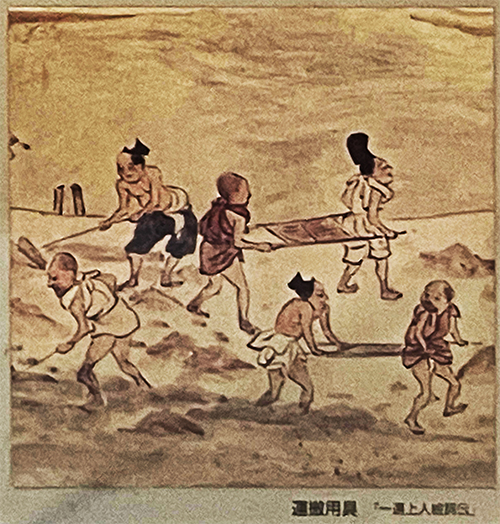
ここまで草戸千軒の「市」としての側面を見て来たけれど、そうした「市場経済」社会の生成はその前提として、社会総体としての農耕生産性の増大ということが前提だったことは言うまでもない。
縄文以来の「伝統的社会」としての狩猟採集ライフスタイルが、大きく変化していったのにはこうした継続的な人為的地形改造、人新世の基盤的な「自然改造」を前提とした農耕的土地利用が、すべてを革新したのだろう。単位面積あたりの人口維持効率では、稲作中心の土地利用こそが日本社会では決定的に重要だったのだと言える。
こうした農業土木を持続的に可能にするために不可欠な集団作業について、支配と被支配という関係性が生まれ、より強力で効率的な権力機構の必然性が高まっていったのだろうと思っています。最初期の権力誇示装置として、巨大土木作業が不可欠な「古墳」造営が日本列島各地で進展したのには、そういう権力構造の基本原理が反映したのだろう。
日本列島社会ではこうした農業土木集団労働の指揮命令権、その妥当性・社会的な「納得感」についての集団間での競争関係があって、それがやがてアマテラス系の人びとによって歴史的に収斂されていったということのように思われるのですね。天皇の伝統的行為の中に農業的営為が幾重にも積層していることは、そういった経緯を表しているのではないか。



この草戸千軒遺跡の展示説明でも、上のような農業土木についての解説画像が提示されていた。もっとも基本的な道具として土を運搬する木製道具「もっこ」と呼称される原形的な運搬具が発掘されていた。こういった運搬具と動員された大量労働力によって、芦田川水系などの天然の水利を有為に改造して、稲作適地を新造成させていった。
日本政治社会の最初期体制として律令的「公地公民」制が導入されたけれど、そうした社会主義的体制では人びとの「やる気」、もっとも基本的な社会発展への活力を創造することができず、やがて荘園公領制(荘園および公領を土台とした重層的土地支配構造。荘園は寄進地系荘園に由来し公領は国衙領に由来する。歴史学者の網野善彦が提唱した学説に基づく)が日本に最適な体制として社会進化させる動因になっていく。この草戸千軒周辺地域でも「沼田荘」という荘園が成立して活発な生産活動の発展のベースになって、やがてこの中世的市場都市が成立していった。
はるかな後年、北海道でもやや違う国家体制のもと人新世的な自然改造が活発に行われて、札幌のような大都会も形成されるに至るプロセスは、わたしの人生時間でも体験できた。案外大事なのは、そうであってもそういう自然改造と本来の自然環境との「調和」ということなのではないか。
北海道は日本の地域の中でも有数の農業生産地域になったにも関わらず、世界の人びとにとっても魅力的な自然風土として愛され続けてきている。聖徳太子が「和を以て貴しとなす」とはるかに日本の国是として政治統治宣言したことは、非常に示唆的と思える。
English version⬇
[Agricultural Production and the Anthropocene Topographic Transformation – Kusado-Senken 2023 Revisited – 13
Agriculture necessitated the modification of nature as agricultural engineering. The political system was tested in conjunction with this so that it could have legitimacy. …
Although we have seen the “market” aspect of Kusado-Senken, it goes without saying that the creation of such a “market economy” society was predicated on the premise of increased agricultural productivity in society as a whole.
The hunting and gathering lifestyle that has been the “traditional society” since the Jomon period has been drastically transformed by the continuous anthropogenic landform modification and agricultural land use based on the basic “natural modification” of the Anthropocene, which has revolutionized everything. In terms of population maintenance efficiency per unit area, it can be said that rice-crop-centered land use was critically important in Japanese society.
I believe that a relationship of domination and subjugation emerged with regard to the collective work that was essential to make such agricultural engineering sustainable, and the necessity for a more powerful and efficient power structure grew. The development of the construction of “kofun” (burial mounds) throughout the Japanese archipelago, where massive civil engineering work was indispensable as a device for the initial display of power, probably reflected such basic principles of power structure.
It seems to me that in the Japanese archipelago society, there was a competitive relationship among groups regarding the command and order authority of such agricultural and civil engineering collective labor and its validity and social “conviction,” which eventually converged historically by the people of the Amaterasu lineage. The multiple layers of agricultural activities layered in the traditional acts of the emperor may represent such a process.
In the exhibition description of this Kusado-Senken site, explanatory images about agricultural engineering, as shown above, were also presented. The most basic tool excavated was a wooden “mokko,” a prototypical earth-moving tool. With these tools and a large mobilized labor force, the natural water resources such as the Ashida River system were converted into suitable areas for rice cultivation.
Although the Ritsuryo (law-based) “public-land civic” system was introduced as the initial system of Japanese political society, such a socialist system failed to create people’s “motivation” and vitality for the most basic social development, and eventually the manor-kommunal system (a layered land control structure based on manors and fiefs in medieval Japan) was established. The manor system was a system of donated lands. The manor derived from the donated land manors, and the fief derived from the national government offices. (Based on the theory proposed by historian Yoshihiko Amino.) The Kusado-Senken area became the driving force behind the evolution of society as the most suitable system for Japan. In the area around Kusado-Senken, a manor called “Numata-so” was established and became the base for the development of active production activities, which eventually led to the establishment of this medieval market city.
In later years, under a different national system in Hokkaido, the process that led to the formation of a metropolis such as Sapporo was also experienced during my lifetime. What is important is to maintain harmony between the natural modification and the original natural environment.
Even though Hokkaido has become one of the most prominent agricultural production regions in Japan, it continues to be loved by people around the world as an attractive natural climate. Is it not highly suggestive that Prince Shotoku declared “harmony is the noblest” as Japan’s national motto for political governance by far?
Posted on 12月 25th, 2023 by 三木 奎吾
Filed under: 住宅マーケティング, 日本社会・文化研究







コメントを投稿
「※誹謗中傷や、悪意のある書き込み、営利目的などのコメントを防ぐために、投稿された全てのコメントは一時的に保留されますのでご了承ください。」
You must be logged in to post a comment.